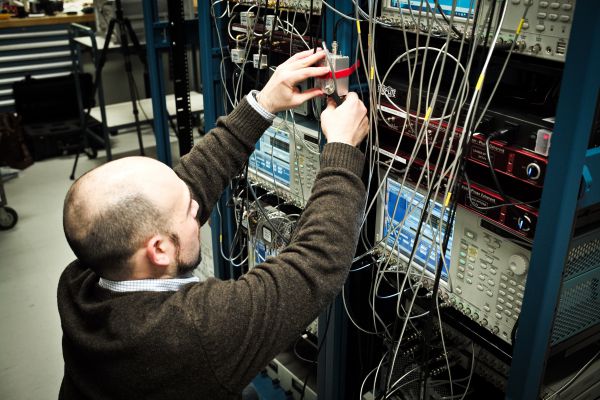
In 1946, John Mauchly and J. Presper Eckert completed the development of the ENIAC, the world’s first publicly announced digital computer. Yet it was still essentially a prototype. It wouldn’t be till 1952, when the pair debuted the UNIVAC during the Presidential election, that computers became commercially available.
That was a triumph for Remington Rand, which backed the machine, but a disaster for IBM, which dominated the earlier tabulating machine technology. It took the company nearly a decade to regain leadership with its System/360 line of computers that cost $5 billion to develop (or about $40 billion in today’s dollars).
We’re now entering a similar transition period. With Moore’s Law soon coming to an end, the race is on to see who dominates the next phase of computing. IBM is determined not to be caught off guard again. This time, rather than developing its new technology in relative secrecy, it’s accelerating progress by giving the public early access to its prototype quantum computer.
Building A Community of Users
IBM has long been a pioneer in quantum computing, a key technology for the next phase of computing. Yet much like in the early days after the development of the ENIAC, very few people understand the technology. So it was with that in mind that the company created its Quantum Experience program last year.
The idea of the program was to give anyone who wanted access to IBM’s 5-qubit prototype so they could begin to experiment with the technology. Quantum computing, it should be noted, has unique capabilities and operates according to a very different logic than classical machines. So getting offered a chance to get some hands on experience is invaluable.
“There is already a research community around quantum computing and they’re already working on things like basic quantum algorithms and quantum games,” IBM scientist Jerry Chow told me. “The Quantum Experience helps support those users, but also extends the community into those who are just getting to learn about quantum computing. We’re training a new generation.”
To date, nearly 50,000 have run roughly 300,000 experiments in IBM’s Quantum Experience. Recently, the company announced that it was expanding the program and introduced a new 16 qubit machine with far more capacity, so those numbers will only grow.
Designing The User Interface and Improving Programmability
Much like quantum computing today, in the early years of digital computing a key stumbling block was unlocking its capabilities. Anyone who wanted to get any utility out of a computer would have to program in machine code, which was horribly cumbersome and prone to error.
That all changed when John Backus created the first programming language, FORTRAN, at IBM in 1957. For the first time, real world problems could be quickly and efficiently transformed into machine language, which made the technology far more practical and useful. In the 1960’s, the market for computers soared.
So IBM has used the community it has built around the Quantum Experience program to better understand how people can get the most value out of the new technology and has learned a lot about which logical operations are most in demand. That has enabled the firm to upgrade the system to functionality more user friendly. For example, it created an API that allows people to access a quantum computer using an existing programming languages like Python.
“As users on Quantum Experience work on problems like estimating the energy levels in a molecule like hydrogen, we learn about their needs and are better equipped to design an interface to serve them, without them having to understand what’s going on a deeper level,” IBM’s Chow says. This also helps build a roadmap for the functionality that future versions should include.
Enhancing Stability
The first computers were made with vacuum tubes, which caused an abundance of problems. First, they tended to overheat and blow out, which meant they had to be constantly maintained and replaced. Second, they led to actual “bugs” in the machinery, as Grace Hopper found in the Mark II, an early successor to the ENIAC.
Even modern days systems are prone to failure when they are taxed, as we saw with the US government’s launch of the healthcare marketplace website during the Obama administration. No matter how much care you take in designing a system, you really don’t know how it is going to function until a lot of people start using it.
In quantum computing, which utilizes subatomic structures so fragile that the system has to be frozen to within a few degrees of absolute zero, getting lots of people to try it out is enormously helpful in dealing with the more mundane aspects of the new technology.
“Having hundreds of people on the system every day forces us to deal with stability issues up front, much earlier in the development cycle than our predecessors did in the early years of digital computing,” says Dario Gil, Vice President, Science and Solutions at IBM. “It forces us to solve the problem of automatic calibration years before we would with a purely experimental prototype.”
Looking Toward The Future
It’s hard to look at early computers, or even mission control at NASA during the Apollo missions, and imagine that we would eventually carry far more powerful machines in our pockets in the form of smartphones. In much the same way, it is nearly impossible to predict where this age of quantum computing will take us.
What is clear is that in the years and decades to come we will have access to machines that are thousands — if not millions — of times more powerful than current technology and that will enable us to tackle complexity on a level unimaginable today. Applications being explored range from encryption to artificial intelligence to medical research.
“We’ve learned a lot from the first computer revolution so now instead of it taking 50 years, hopefully we’ll be able to advance much faster,” Gil told me excitedly. “”In the years to come, we will see new generations of machines and algorithmic approaches that will be able to solve problems of increasing industrial and commercial value.”
He then continued thoughtfully, “I think that when we look back we will see this period of time much like we look back at the development of the ENIAC in 1946, when a number of exciting of ideas actually galvanized themselves into a machine that can actually solve problems.”
We can never know what the future holds, but as the current era of digital technology comes to an end, what is clear is that we are entering a new age in which possibilities expand once again.












